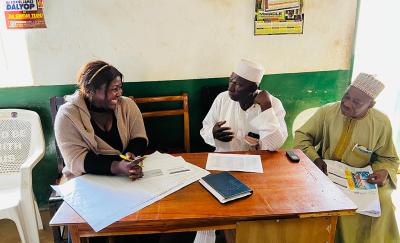After Dobbs v. Jackson: The Desperate Need for Access to High-Quality Maternal Health Care




After the Supreme Court announced it was overturning Roe v. Wade, shock waves were felt across the country. This swift and drastic change had sweeping effects due to “trigger laws” that, in some states, automatically (or, in some cases, within 30 days) reverted to the rule of law that existed prior to the 1973 Roe v. Wade decision. As a result, many people must travel across their home state (or across multiple states) to obtain reproductive health care services. Still others will have to go without those services.
The public health system in the United States must anticipate that, as a result of this decision, the number of pregnant people at risk of poor outcomes will increase. Already in our country, Black and Indigenous pregnant people, and those living in rural areas, experience worse maternal health outcomes. These populations often have limited access to culturally appropriate prenatal and perinatal care. With recent studies demonstrating that 3 out of 5 of pregnancy-related deaths are preventable in the United States, this indicates the need to leverage a cross-sector effort to provide more support to people before, during, and after pregnancy. Yet as some states implement policies further limiting access to abortion services, it is possible that the number of individuals experiencing unplanned or unwanted pregnancies will increase, while their ability to participate in early and adequate maternal healthcare may become even more difficult.
The need to improve access to the full range of family planning and maternal healthcare through existing federal programs, particularly in states that have or may limit access to the full range of reproductive services—including abortion care—are greater than ever. To help implement the White House Blueprint for Addressing the Maternal Health Crisis, HRSA recently announced $20 million in investments to foster innovation and improve quality and access to maternal and child health care. Other investments include the Alliance for Innovation on Maternal Health (AIM) to improve access to high quality maternal health care in communities that need it most. AIM is a maternal health safety and quality improvement initiative funded by the U.S. Department of Health and Human Services’ Health Resources and Services Administration (HRSA) Maternal and Child Health Bureau (MCHB) and operated by the American College of Obstetricians and Gynecologists. AIM supports states and health systems efforts to adopt evidence-based patient safety best practices (packaged as “safety bundles”) to improve the quality of care for pregnant and postpartum people.
AIM has been critical to advancing maternal health outcomes in participating states, and this initiative can be leveraged to even further protect the lives of birthing people with limited access to high quality maternal health care. These opportunities include:
- Helping non-participating states to join AIM. As of June 2022, only five states are not participating in AIM (i.e., Arkansas, Idaho, North Dakota, South Dakota, and Wyoming). Unfortunately, each of these states have established “trigger laws” intended to limit access to abortion services with the overturning of Roe v. Wade. By participating in AIM, birthing facilities in these states will be better positioned to provide high quality perinatal services to the possibly increasing number of individuals with unplanned pregnancies, or among individuals who may not have chosen to remain pregnant if access to abortion services were available.
- Broadening birthing facility participation within participating states. Though the intent is that 100 percent of all birthing facilities will participate in state AIM initiatives, facility participation in each state varies greatly. Often, those facilities that choose not to participate are among the most under resourced (e.g., rural, Tribal, safety-net), and serve those populations that experience the worst maternal health outcomes. By providing intentional technical assistance and reducing the burden of participation (e.g., data collection and reporting requirements), AIM and its participating states can expand the adoption of maternal safety bundles to communities in most need of high-quality perinatal services.
- Improving the uptake of core safety bundles among participating hospitals. Similar to the goal of achieving 100 percent birthing facility participation in AIM, ideally, each facility would also adopt all available core patient safety bundles. Currently, the core bundles include Obstetric Hemorrhage, Severe Hypertension in Pregnancy, Safe Reduction of Primary Cesarean Birth, Care for Pregnant and Postpartum People with Substance Use Disorder, and Postpartum Discharge Transition—each of which align with the leading causes of maternal mortality in the United States and are the conditions most exacerbated among Black, Indigenous, and rural populations. By expanding adoption of these bundles, birthing facilities can become better prepared to safely care for the most vulnerable pregnant and postpartum individuals.
- Expanding AIM participation to outpatient and emergency health care settings. While some patient safety bundles incorporate components for the prenatal and postpartum stages, AIM implementation has largely been focused on improving maternal health care in inpatient labor and delivery settings. Though maintaining optimal readiness to address maternal emergencies in birthing facilities is critical, this does not address barriers to care for birthing people living in maternity care deserts or areas with low access to maternity care. To this end, it is increasingly important to engage maternal health practitioners who provide care in outpatient settings, as well as other providers who may intentionally or unintentionally be providing care to pregnant and postpartum people (e.g., family practice, emergency departments, urgent care, critical access hospitals). Fortunately, the AIM Community Care Initiative is working on a pilot program to implement non-hospital focused maternal safety bundles, but all states, especially those with vast areas with low access to reproductive services and maternity care, should proactively engage non-traditional providers in maternal safety education and initiatives.
- Promoting the Reduction of Peripartum Racial and Ethnic Disparities bundle to a core AIM patient safety bundle. Disparities in and the impacts of racism on maternal health outcomes are well documented. Both AIM and the AIM Community Care Initiative have a clear commitment to equity within their programs, with goals to reduce preventable maternal mortality and morbidity among the most disparate populations. Understanding that the overturning of Roe vs. Wade will have the most prominent impact on birthing people with limited access to high-quality maternal healthcare, it is critical that all healthcare facilities serving these populations are prepared to deliver services in a manner that is non-stigmatizing, culturally responsive, and tailored to meet the unique needs of individuals regardless of their circumstances. To this end, the Reduction of Peripartum Racial and Ethnic Disparities bundle should be promoted to a core patient safety bundle and prioritized for implementation—particularly in states with limited access to abortion services.


While AIM is an essential component of improving access to high-quality maternal health services, there are other federal opportunities to prevent unintended pregnancies and improve health outcomes among birthing people in the United States. President Biden has recently signed an executive order aiming to improve access to and awareness of reproductive health services, including family planning services through the Title X program, emergency contraception, and protections for birthing people experiencing pregnancy loss. In addition to Title X, programs such as federally qualified health centers, the Title V Maternal and Child Health Block Grant, Healthy Start, and Maternal, Infant, and Early Childhood Home Visiting programs will be essential in supporting birthing people and their families before, during, and after pregnancy.
Abt is committed to leading the public health response for the consequences of the Supreme Court’s decision to overturn Roe v. Wade. We will leverage existing relationships to mobilize resources to not only respond to research and evaluation needs, but also to stand up research teams for rapid implementation. At Abt, equity is central to everything we do. Our mission is to advance health and economic well-being for all, and we recognize that doing so requires applying a social justice lens to identify and address historic and systemic inequities that manifest in many ways for many different people, including those most affected by the Dobbs vs. Jackson decision.
Read More

Pathways to UHC: Nigeria’s State and Local Approaches to Financing Integrated HIV Services and Primary Health Care
Nigeria’s state and local government-driven approaches to integrated primary health care are transforming financial protection and access for vulnerable populations, setting a replicable model for sustainable universal health coverage.

Healthcare & Public Health - October 2024
How to Improve Primary Care Quality, Coordinating the Response to HIV/AIDS, and More from Abt Global

American Public Health Association (APHA) 2024 Annual Meeting & Expo
Abt is a sponsor and exhibitor at the American Public Health Association (APHA) 2024 Annual Meeting & Expo in October 2024.
